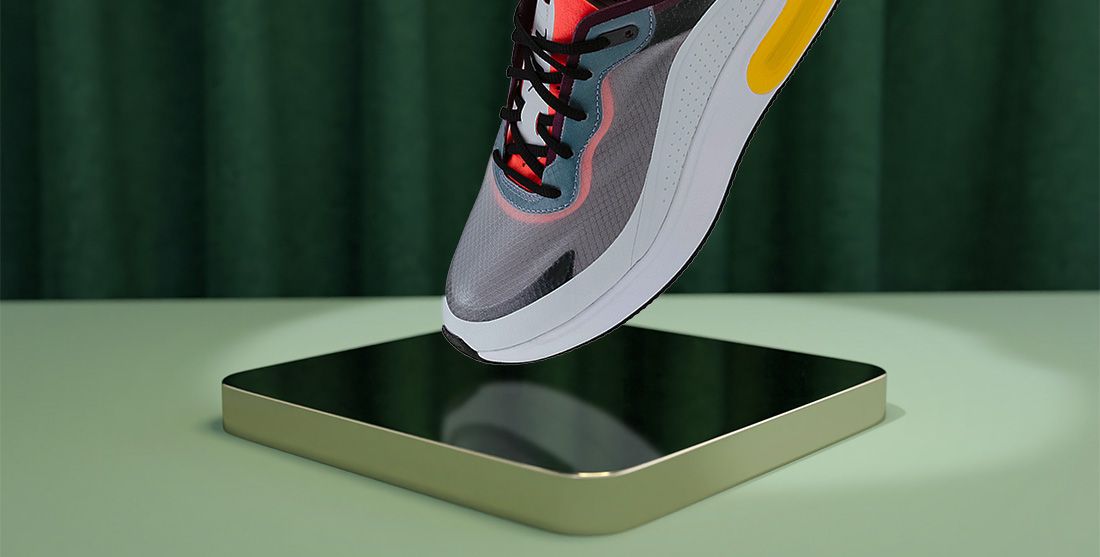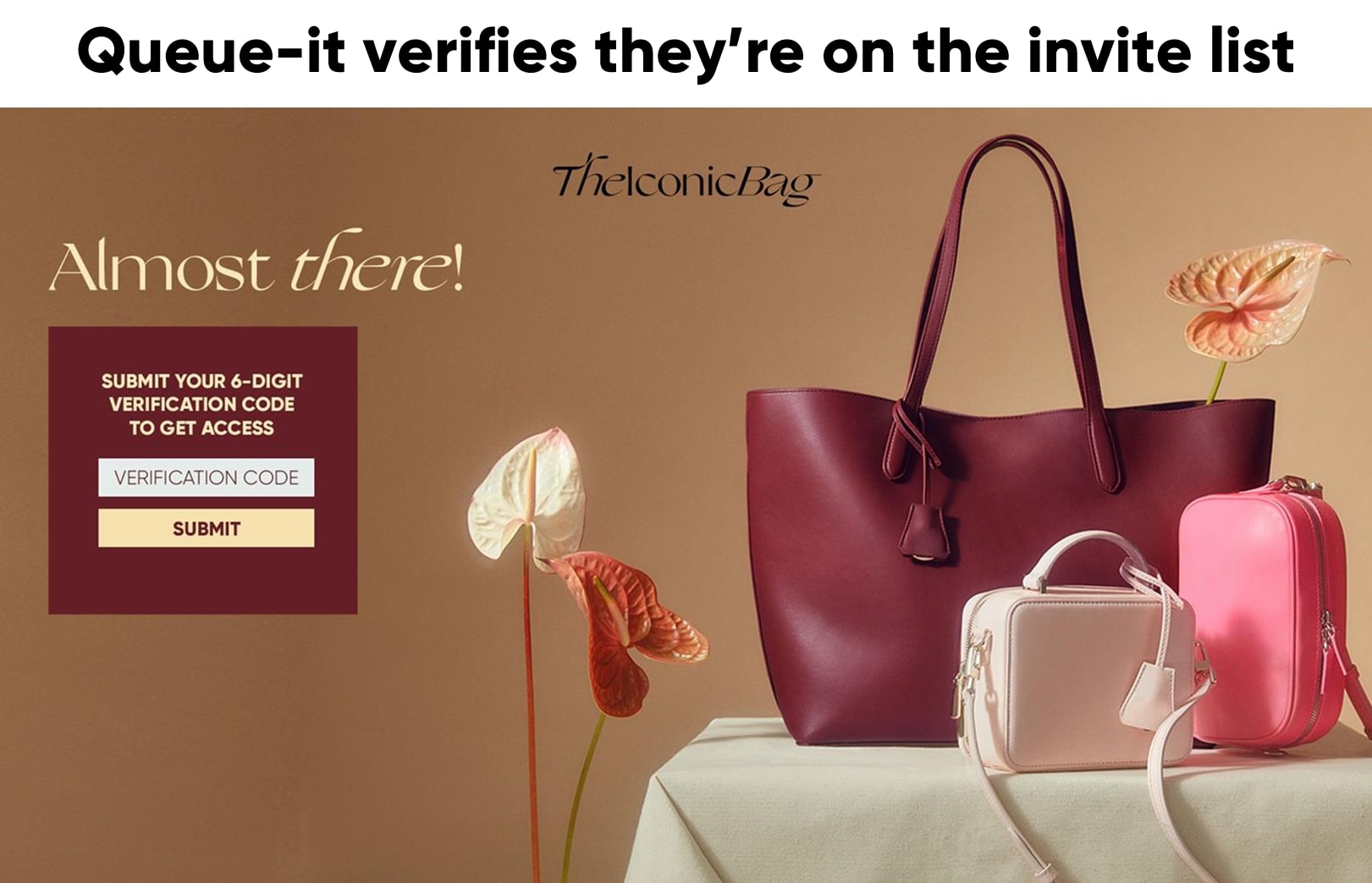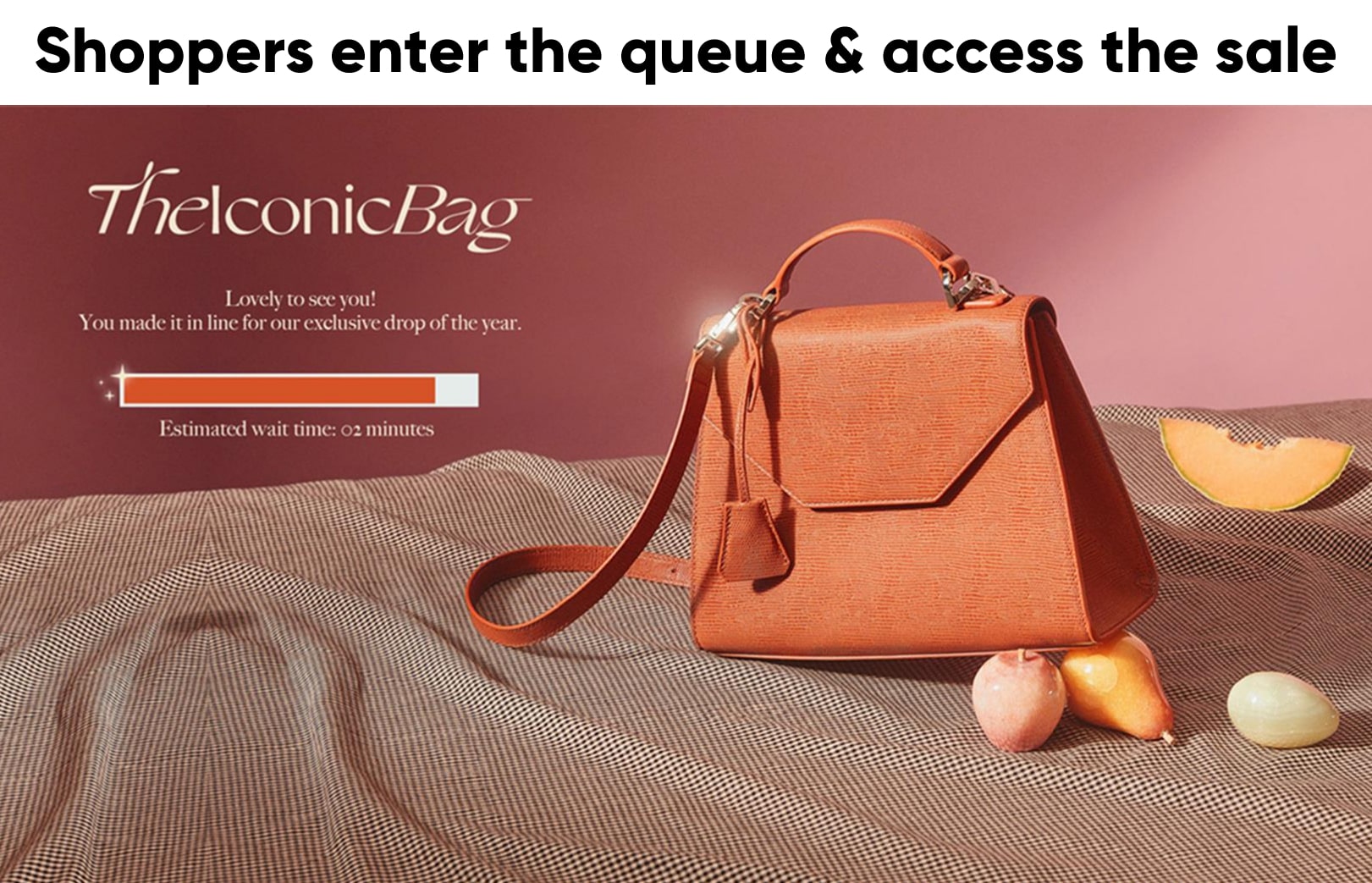Major retail brands are embracing the product drop model for its capacity to create hype and drive sales. But these brands are quickly learning product drops aren’t as simple as ordinary sales. Website crashes, overselling, bot attacks, problems of fairness—the uncontrolled traffic drops attract pose problems ecommerce stores aren’t used to. Discover the 6 common product drop challenges major retailers face and how taking control of web traffic can help you overcome them.
Product drops and brand collaborations have exploded onto the ecommerce scene. Nike, GAP, Prada, Target, Levi’s—everyone’s doing them.
While the product drop model is a proven strategy for building buzz, incentivizing loyalty program sign-ups, and boosting sales, it brings with it a challenge most retail sites just aren’t built to handle: massive, uncontrolled web traffic.
Crashes. Costs. Customer complaints. If you can’t control your web traffic, your product drop dream can quickly turn into a nightmare—for both your customers and your company.
From over a decade working on high-demand, low-supply sales and drops from brands like the North Face, Rapha, SNIPES, Fenty Beauty, and Ticketmaster, we’ve learned a lot about how to pull off high-heat events successfully.
In this article, we draw on these insights and showcase stories from some of the biggest product drops out there to outline the key challenges drops pose and how taking control of web traffic is the secret to overcoming them.
6 common product drop challenges:
Product drops are a recipe for hype and high traffic. Don’t believe us? Just look at the dozens of major websites that have crashed from the demand for their drops.
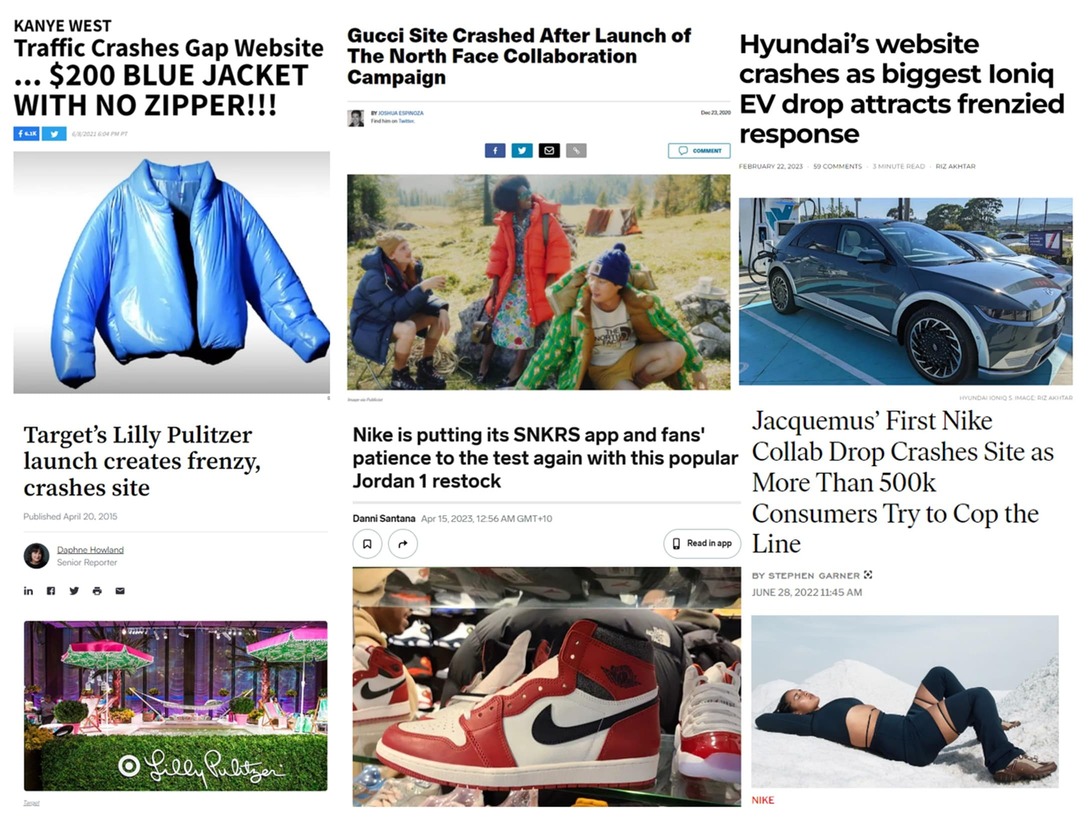
GAP, Gucci, Walmart, Target, Nike, Jacquemus, SKIMS—even Hyundai’s site crashed when they dabbled with the product drop model for their limited-quantity electric vehicles.
Product drops and brand collabs have become such a major trend precisely because they work so well to create hype and buzz. Customers rush to websites in droves because they know quantities are limited. They know the product will sell out. They know it might be their only chance to get it.
This all sounds great. But if you’re unprepared—like the many sites above were—the web traffic spikes these drops attract will bring your site crashing down.
Website crashes create enormous costs, with crashes during drops:
- Harming sales: customers can’t check out on a website that doesn’t work
- Draining resources: IT teams work frantically to restore the site, while customer service and marketing teams work on crisis management
- Damaging reputation: customers turn to social media to complain and journalists quickly write hit pieces about your botched drop
- Threatening relationships: your failure reflects poorly on your collaborators, who question whether you’re the right brand to work with
"Downtime of even one to two seconds can be very costly. When you multiply that by 60,000-100,000 people, that adds up. Whenever anyone else is involved as well, influencers or another brand, we don't want to affect how their audiences view them."
ALEX WAKIM, DIRECTOR OF OPERATIONS & BUSINESS DEVELOPMENT

The problem for most retailers entering the product drop space is that their websites just aren’t built for the sudden traffic spikes drops create. Unless you’re a brand that operates almost entirely on a product drop model—like Supreme or Palace—it’s just not efficient or cost-effective to design your systems in this way.
RELATED: Why Websites Crash Due to High Traffic & How to Prevent it
When cycling apparel brand Rapha was preparing for a drop with a major streetwear brand, for example, they were shocked to hear the sheer volume of the traffic their collaborators usually saw. Tristan Watson, Rapha’s Engineering Manager, told us:
“Our partner only releases using this product drop method. Their whole technology stack is built around selling out—fast. In our first meeting, they disclosed they had seen 100,000 requests every few minutes. Unlike the partner, we work in a more traditional sales model, meaning our infrastructure isn’t designed to deal with the compressed traffic spikes you get during a ‘hyped’ drop.”
That’s why, rather than re-architecting their systems for the hyped drop, Rapha used Queue-it’s virtual waiting room to take control of their traffic and handle demand.
A virtual waiting room lets you control the flow of online traffic to your website or mobile app. Rather than letting 10,000 people onto your site all at once, it automatically redirects visitors who hit your site or product page to a fully customizable online queue that sits off your infrastructure.
From there, you can flow visitors smoothly from the waiting room to your website at the rate your site can handle—whether that be 10, 100, or 1,000 per minute.
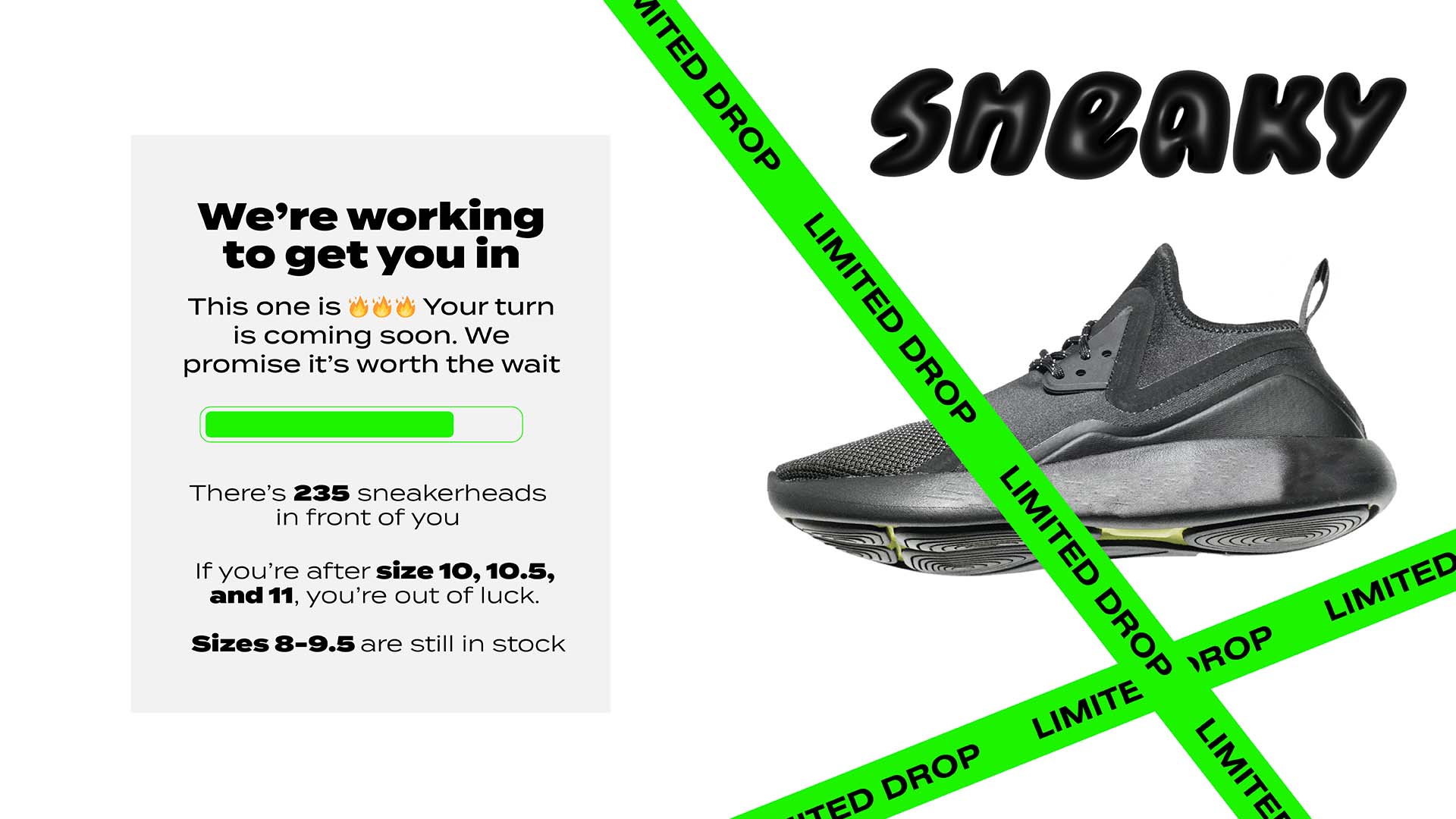
It’s the same way physical stores have always handled huge crowds of customers for events like product drops. Just taken online.
"The server infrastructure mess was something we did not want to continue with. Nobody builds a website to handle hundreds of thousands of people just for a limited amount of time ... Queue-it is a great solution that saves the day and it works flawlessly."
RobeRT WILLIAMS, DIGITAL MANAGER

Customers are drawn to drops because they want products that are limited in quantity—products not everyone can have. In fact, 45% of consumers say they’re interested in drops specifically because they value access to products that are difficult to obtain.
But combining high demand with low supply is dangerous, and not just because it can crash your site.
A common problem brands running product drops face is the overselling of products. One major apparel brand, for example, told us the number of products they sold during their hyped drop was equivalent to the number of products they oversold.
That means for every parcel they sent out, they had to send out another “We’re sorry, your order has been cancelled” email.
Twitter and Reddit were, of course, full of complaints. Their support team had to deal with hundreds of frustrated customers. And the product drop that was supposed to elevate their brand image ended up tearing it down.
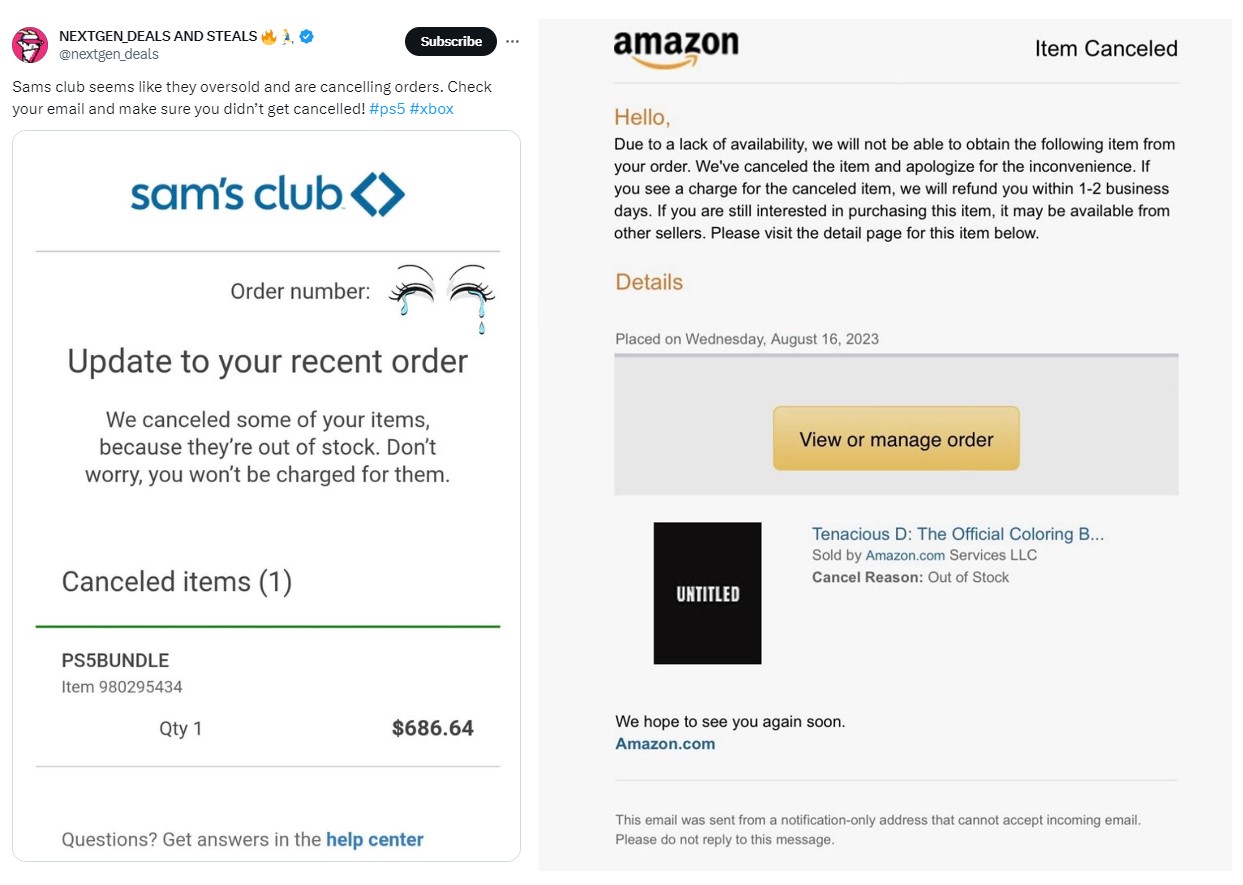
Why does this happen? Why are product drops prone to overselling?
Product drops oversell because databases and inventory management systems often can't keep up with the sudden surge of orders. By the time they’ve registered the first batch of orders and updated inventory, hundreds of other customers have already checked out.
Product drops succeed through scarcity marketing. They’re rare, limited-quantity items. This means there's no "next shipment" on the way. You have to cancel oversold orders.
This was the problem German football team Borussia Dortmund (BVB) faced when releasing limited-edition merchandise.
Their surprise merch drops created a rush on the products that their inventory system couldn’t keep up with. To solve this, they used Queue-it’s virtual waiting room to slow down the traffic to a level their systems could manage, so they could capture every sale—and not one more.
"The biggest benefit to Queue-it is that you really can manage how many people are on the site and ensure everything works and the customer ultimately gets the product he or she has bought."
MATTHÄUS FRANKE, HEAD OF ECOMMERCE, BVB MERCHANDISING
Last year, a top 10 footwear brand dropped an exclusive line of sneakers. Traffic to the site soared. The sneakers sold out.
Everything seemed to go according to plan. But behind the scenes, something was wrong.
Queue-it ran a post-sale audit on this drop and found up to 97% of the activity was non-human—clicks, visits, and requests from malicious bots designed to snatch up product to resell it at huge markups.
Of the 1.7 million visitors who tried to access the drop, less than 100,000 were playing by the rules.
For hyped product drops, human-to-bot ratios like this aren’t uncommon. If your product is limited in quantity and can be resold for profit, then resellers will do everything they can to snatch them out of the hands of your real customers.
Bots add to existing product drop problems like site overload and overselling. But they also create new issues:
- Bots harm customer trust & loyalty
- Bots make you miss connections with genuine customers
- Bots jeopardize business and partnership contracts
- Bots increase operational & support costs
- Bots create faulty analytics for decision making
RELATED: Everything You Need to Know About Preventing Online Shopping Bots
Bad bot traffic creates real, concrete costs. But working to keep resellers off your site isn’t just practical, it’s ethical.
Real customers love your products. Resellers love the profit they can make off them. Who would you rather sell to?
A virtual waiting room keeps bots off your site like a security checkpoint at an airport keeps bad actors off flights. It sits between a webpage on your site and the purchase path. As visitors flow through it in a controlled, orderly manner, you can run identification checks that determine whether they get to pass through.
The “identification checks” for identifying and stopping bots with Queue-it’s virtual waiting room include:
- Data center blocking
- Proof-of-Work challenges
- CAPTCHA tests
- Blocking or challenging traffic based on reputation scores
- Blocking or challenging traffic based on anomalous behavior
- Randomization of traffic
- Invite-only access management
With bots and abuse protection features enabled, the waiting room not only lets you control the flow of traffic, but also the quality of traffic. It empowers you to filter out bad actors to create a fair and smooth product drop experience you can take pride in.
Ticketmaster has blocked over 13 billion bots across more than 17,000 events using Queue-it’s virtual waiting room.
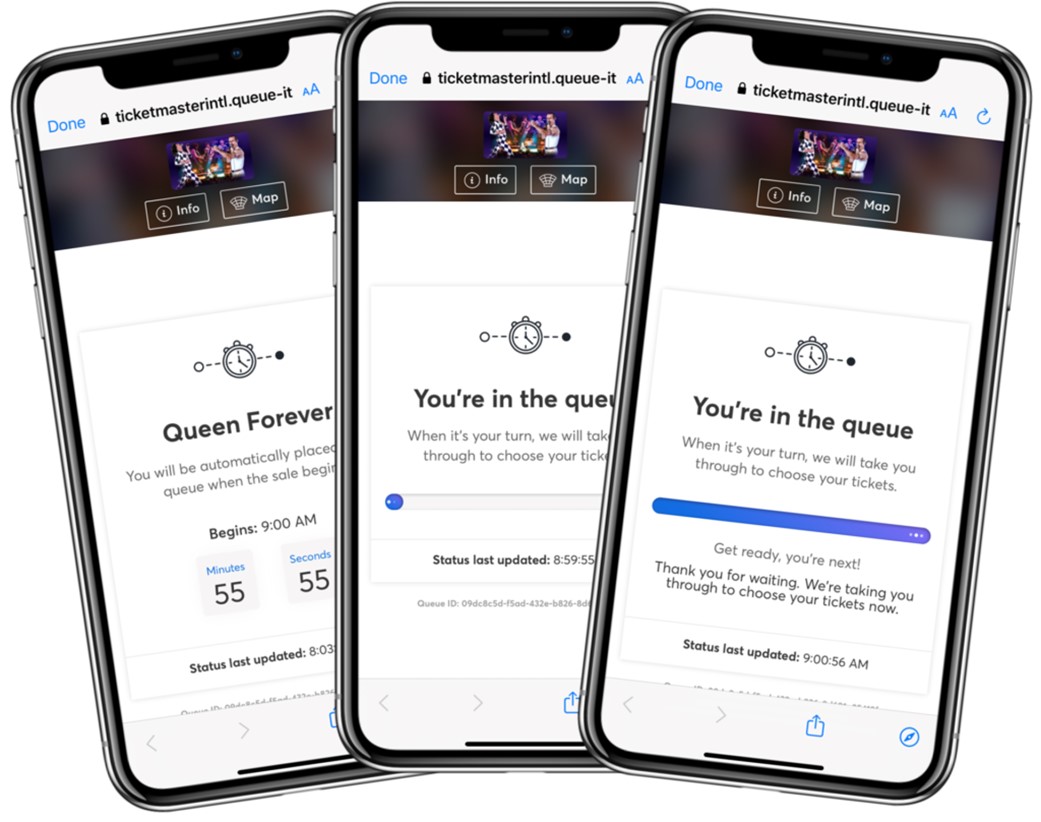
Bots or not, brands running limited-inventory product drops face a complex question:
If more people want our products than can have them, how do we decide who gets them?
The answer is more important than you might think. Researchers have found that fairness accounts for 80% of the variance of trust in online retailers. This increased trust has a domino effect on other measures, accounting for 71% of the variance in customer satisfaction and 56% for customer loyalty.
This makes fairness one of the strongest determinants of customer trust, satisfaction, and loyalty in ecommerce.
Fairness is essential for creating a product drop experience that inspires trust in and loyalty to your brand. Blocking bots is a huge part of creating fairness, but so too are clearly defined sales mechanisms and procedures.
Research shows the best way to fairly allocate limited-inventory goods is what’s called procedural fairness, meaning fairness in the decision-making processes and procedures.
Common examples of this include decisions made by flipping a coin, rolling a die, or drawing straws. In these situations, people are typically satisfied with the outcome, even if it’s not what they hoped for. They can’t be mad because they know the decision was made by the fair procedure of randomization.
In addition to a pre-defined drop procedure such as randomization, it’s best practice to have a scheduled time your product will “drop”. This helps build hype and lets customers prepare—taking a small advantage away from the automated bots that are always at the ready.
When we spoke to Japanese burger chain MOS BURGERS—whose collaborative toy drops with big brands like Nintendo are a smash hit—they told us their customers specifically requested sales to be run in this way:
“Previously, we’d just announce the date of the sale. But after many requests from customers, we decided to announce the specific time of the launch too.”
That’s why Queue-it has a set of features designed specifically for scheduled sales and procedural fairness.
The live raffle (or pre-queue) system sends early visitors to a branded page with a timer that counts down to the time you’ve set your drop to go live.

This pre-queue waiting room acts as a virtual holding area for visitors, building hype and anticipation for the sale.
When the timer hits zero, all the visitors in the pre-queue are randomized (like a raffle, but in real-time), and automatically assigned a spot in the queue.

After the randomization, customers proceed to the product page according to their queue number, and latecomers are placed at the back of the queue.
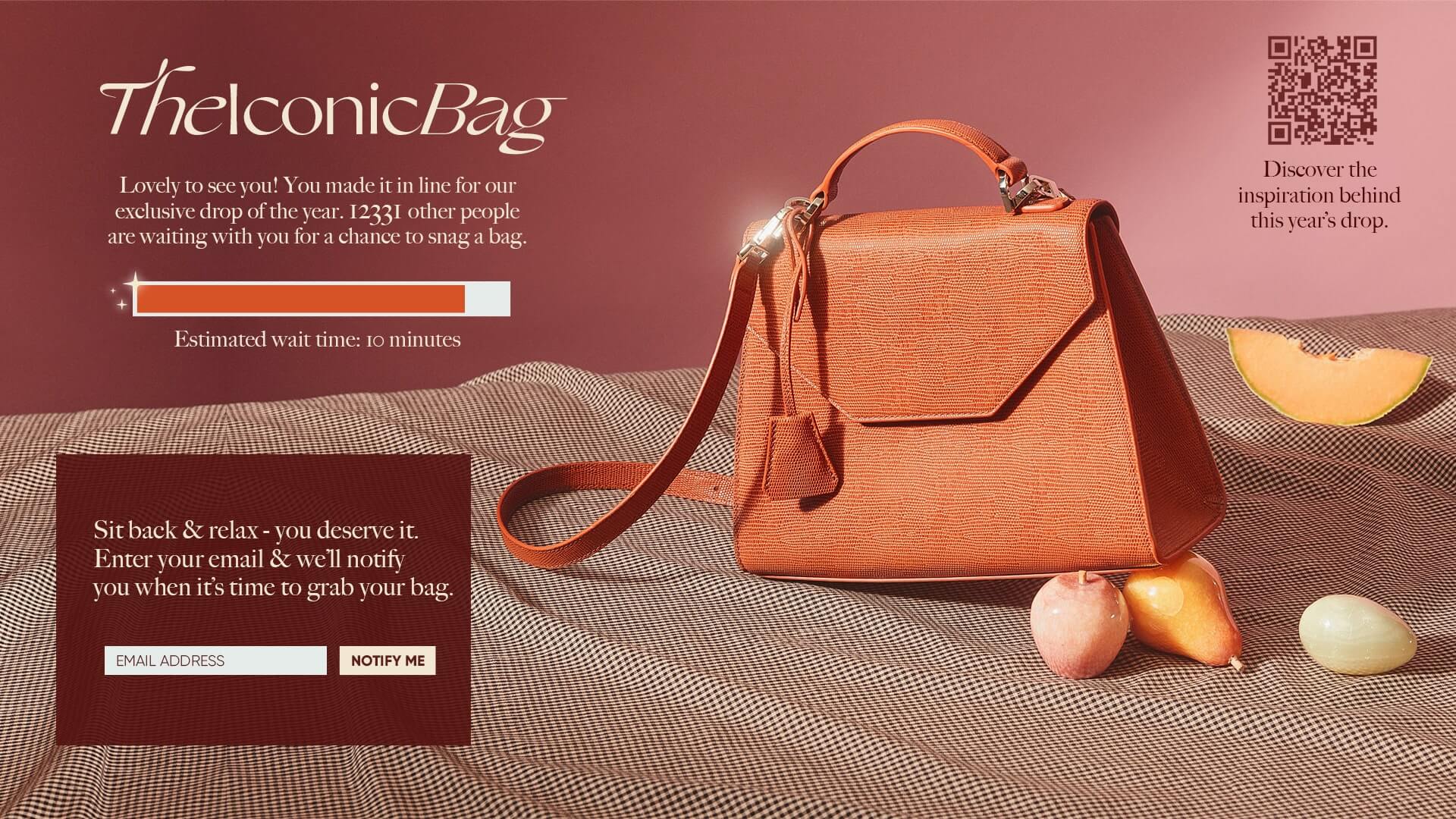
You can read more about the why major retailers are embracing the live raffle system here, but its benefits include:
- Providing the fairness of randomization
- Prioritizing customers who show up on time or early (vs. latecomers)
- Removing speed advantages from bots
- Delivering a transparent experience for customers
- Generating hype and anticipation for your drop
- Keeping customer data secure
"We have more people who want to buy the offer than we have stock, which is the reason we use Queue-it. It allows us to put in place a lottery in order for us to pick users from the queue at random in the fairest manner possible."
PIERRE DOMINIQUE PUTALLAZ, SENIOR FRONT-END ENGINEER

Product drops are the perfect opportunity to reward loyalty customers and incentivize loyalty program sign-ups.
After the kinds of loyalty program benefits that cost you money (like free shipping and discounts) early and exclusive access to sales and new products are the number one benefit loyalty program members want.
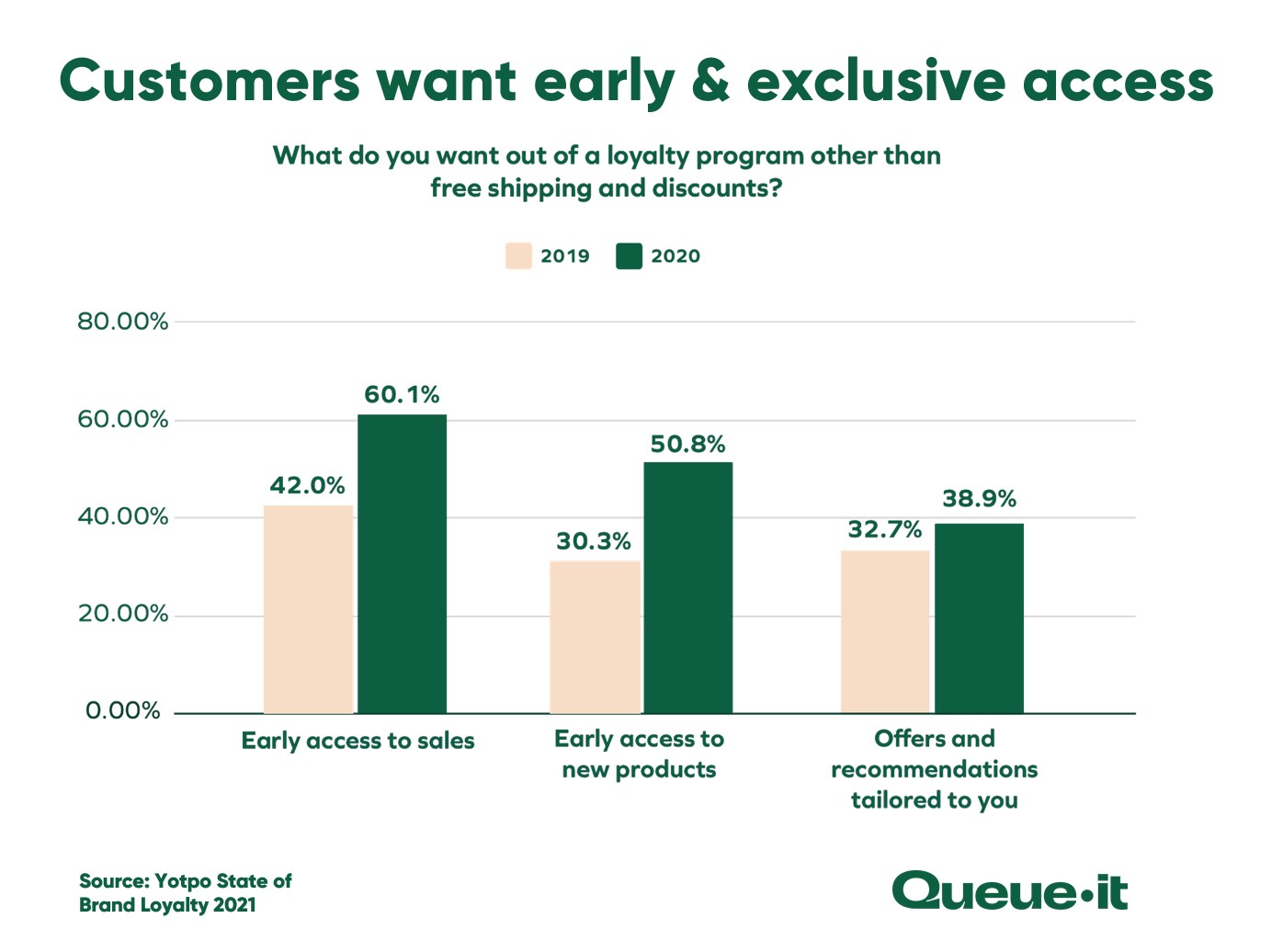
Early and exclusive access is a win-win: customers get a fair and competitive advantage by signing up to your loyalty program, and you provide a strong incentive for sign-ups that doesn’t involve discounting products or spending money on free shipping.
But gating access to exclusive sales is difficult to get right, especially for hyped product drops where bots and resellers stand to profit off their purchases. Most “exclusive” sales still face many of the challenges we’ve covered above: performance issues, overselling, bots, and unfair allocation of products.
When you send out early access or links exclusively to members, resellers quickly find these and share them with their cook groups.
When you gate access behind a login, you can’t control the flow of members to the product page, and credential stuffing and cracking bots will work hard to try steal customer accounts.
That’s why Queue-it has developed the Invite-only waiting room, a secure and scalable way to control sales access and engage and grow your customer base.
With the Invite-only waiting room, only the customers you choose get to access your sale. To set it up, you simply:
- Upload the list of customers you want to invite to your drop or give early access to
- Send out unique, single-use links OR add an email verification field to your waiting room page
- Run your drop, confident no one but the people you want can get access
Scroll through the carousel below to see the user experience your customers can get when using the Invite-only waiting room.
You can use the invite-only waiting room to offer secure access exclusively to members, or set up an early access queue to let members purchase first, then open access to the general public.
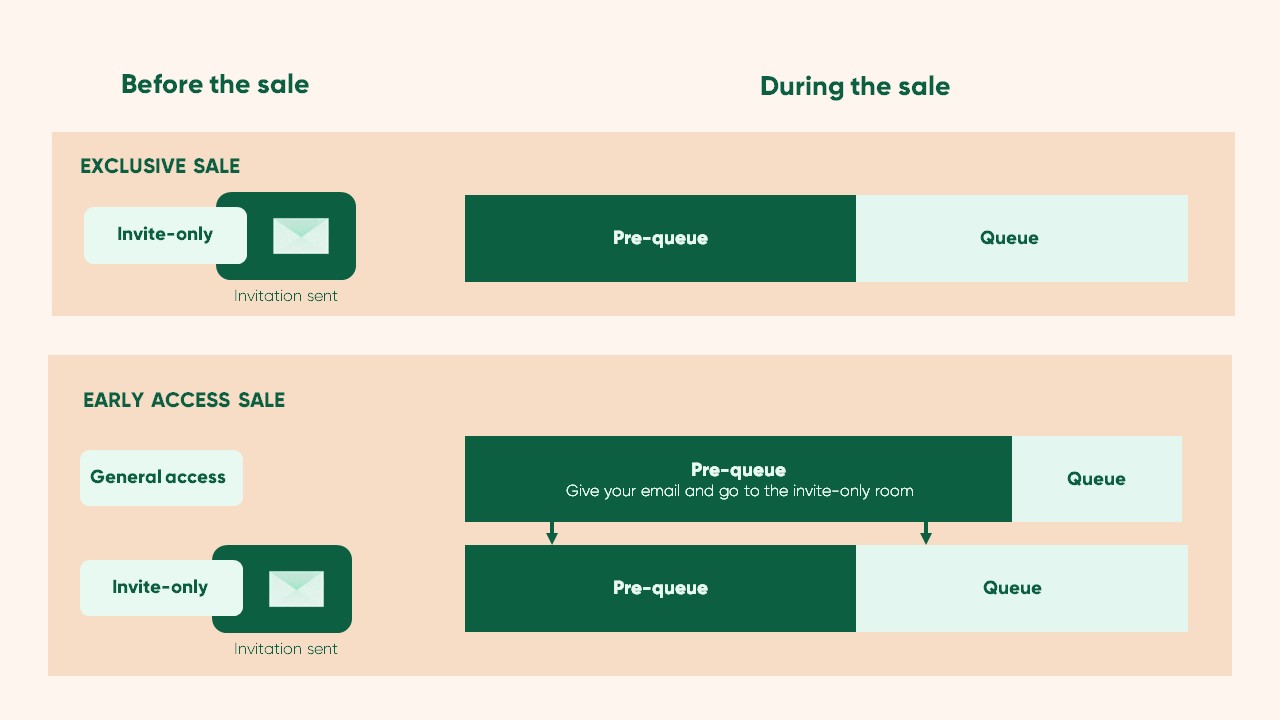
The invite-only waiting room lets you use your hyped drop as an opportunity to reward loyal customers and incentivize sign-ups to your loyalty program. It empowers you to turn demand into data.
One major apparel brand we work with, for example, puts their loyalty program sign-up form on the general access queue page. They offer customers instant access to the faster Invite-only queue if they sign up to the loyalty program. Across just two drops, this technique has driven over 50,000 new loyalty program sign-ups.
RELATED: Reward Loyal Customer with Invite-Only Waiting Rooms
“Running the sale with Queue-it in place made sure we achieved our goal of delivering an enhanced experience for our loyal members. We gave them the priority access we had promised them as a cornerstone membership benefit.”
TRISTAN WATSON, ENGINEERING MANAGER
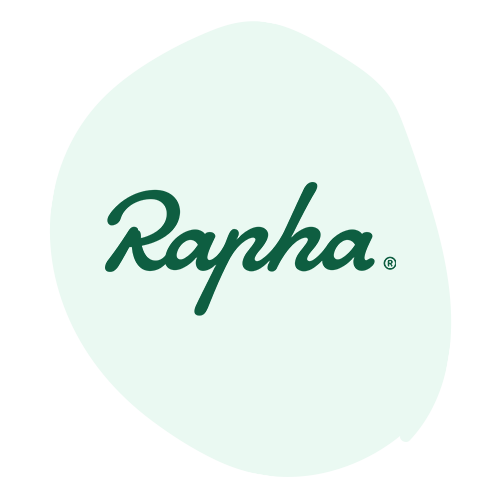
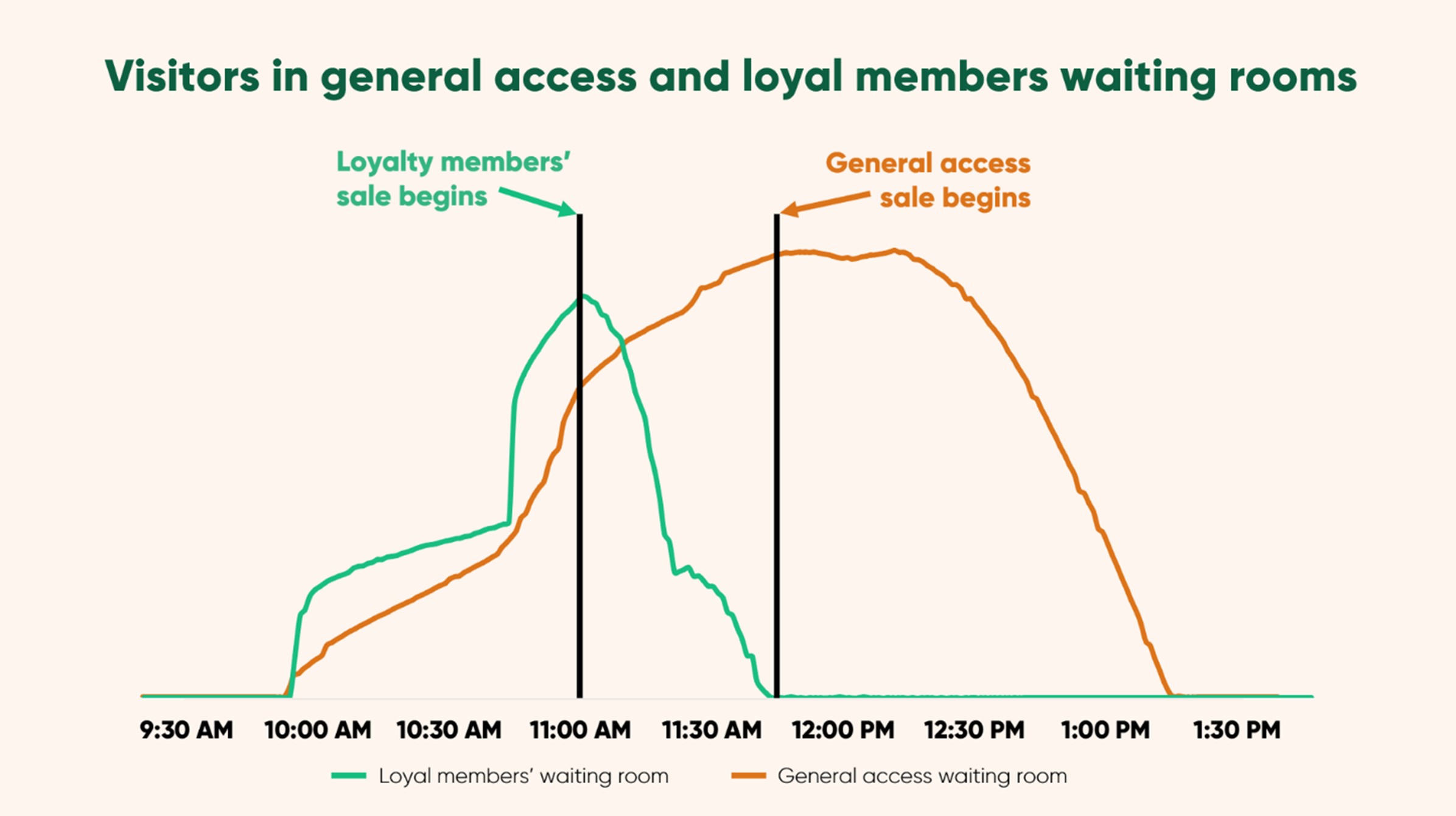
Rapha gave loyalty program members first access to their hyped product drop, only opening general access once all members had a chance to purchase
Product drops are your brand moment. When done right, they can reinvigorate your brand, driving up hype, brand affinity, and sales of core products.
New Balance serves as a perfect example of this.
They launched their first dedicated collaborative strategy in 2018. Within a couple of years, this strategy took the brand from dad fashion to high fashion.
New Balance saw search interest for the brand triple within 5 years. They saw virtual waiting rooms with over 70,000 people trying to get into their drops. They saw their sneakers worn by models, rappers, actors, and influencers. And they saw a suite of instant sell-out and smash-hit sneakers.
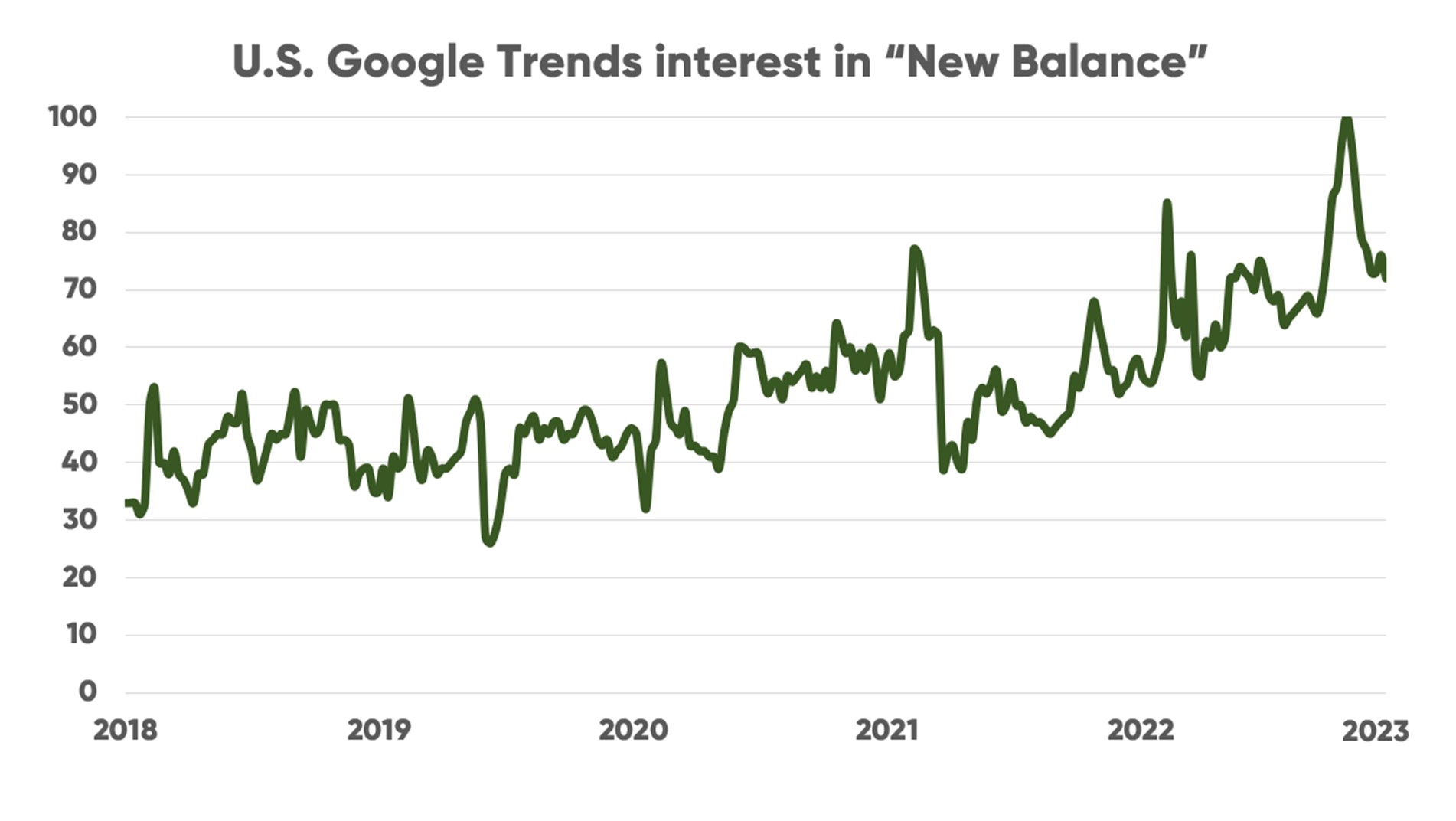
New Balance’s product drop strategy isn’t just about selling the hyped sneakers it drops. It’s about elevating the entire brand.
RELATED: Product Drop Strategy: 14 Simple Steps for Product Drop Success
Nailing a product drop is like signing a star NBA player who lifts the performance and profile of the whole team up with them.
But to achieve this, you need the star player (your star product) to work with the other team members.
The aim of your product drop should be to sell out, sure. But there are several secondary goals that are just as important. You want to capture and nurture loyalty. You want to get people talking and boost brand visibility. You want to cross-sell products.
A virtual waiting room is a technical tool to control web traffic, but it’s built with consumer psychology at its core, and can work to help build hype, increase conversion rates, and boost sales across the board.
“Being able to show how many people want the product helped us create hype and enhance our brand power. It’s a bit like how the popular kids at school get even more popular. We saw this especially in the cross-selling effect on our other products, which tripled in sales during the drop.”
TAISHI MIZUNO, CHIEF MERCHANDISING OFFICER

You can get an in-depth look at how waiting rooms improve conversion rates in our blog here. But there’s a few core tenets of a virtual waiting room’s impact on conversions and hype that are worth highlighting here:
- Cross-selling & showing off products: the waiting room slows customers down on a fully customizable page, giving you a chance to promote your other products and deals
- Social proof: queues show off your drop’s popularity, increasing customers’ purchase confidence and your brand image
- Sunk cost bias: visitors who've waited for something are more likely to convert and spend more, so as not render their time spent queuing wasted
- Scarcity marketing: queues combine scarcity and social proof to create competition over goods and FOMO for customers—a key ingredient of a successful drop
- Fast websites convert better: the waiting room keeps your site running at optimal capacity, keeping you from losing customers due to slow load speeds and errors
RELATED: How You Can Optimize Conversions with a Virtual Waiting Room
Queue-it is fully customizable, meaning many companies get creative and use their waiting room as a piece of marketing material. Companies embed on their waiting room page:
- Videos & trailers
- Special promo codes
- Digital catalogues & menus
- Music playlists
- Email forms for customers to sign-up for loyalty programs & newsletters
- Links to company social media accounts
When customers are in your waiting room, you have their attention. If you make the most of that attention, you can boost your sales once they proceed to your site.
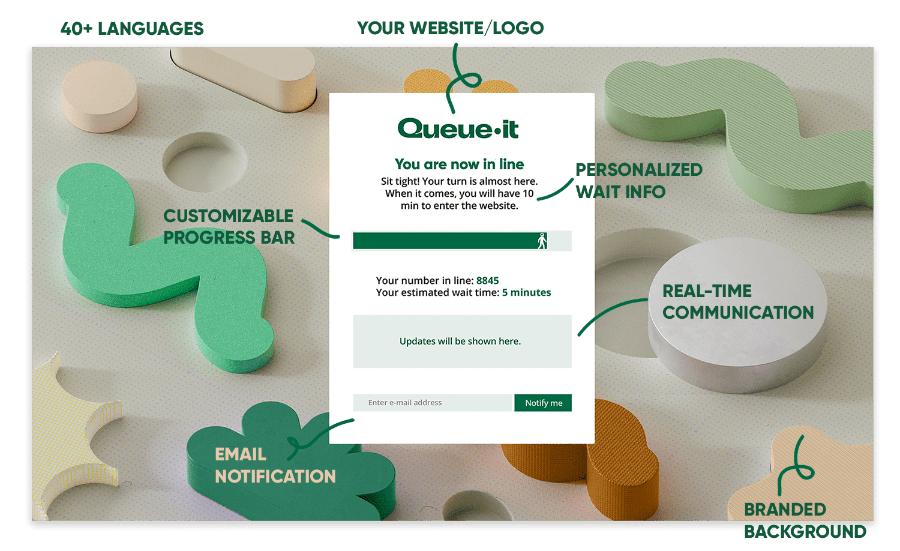
While product drops in retail picked up steam in the past 5 years, the basic model behind them goes back a long way.
Product drops take the ticketing model into retail. The nature of ticketing is an event occurs over a limited time span, and the amount of people that can attend—seats available in the theater, stadium, etc.—is also limited.
Similarly, product drops typically only occur once, and involve the sale of products where supply is limited.
Like ticketing, product drops create scarcity, competition, and urgency for buyers. If you aren’t there when the ticket or product releases, if you aren’t willing to queue and work for it, you probably won’t be able to buy it.
Because of the mismatch between supply and demand, ticketing has always inspired hype and large queues. It’s the first industry that saw scalping and reselling on a wide scale.
Today, the product drop model creates these same effects for retailers. And as these retailers increasingly shift to ecommerce, they’re turning to the solution the world’s biggest ticketing companies have relied on for years: virtual waiting rooms.
Virtual waiting rooms offer complete control over web traffic, addressing the common problems even the biggest retailers face when running drops. Level up your product drop strategy with Queue-it’s waiting room to:
- Keep your website or app online, no matter the demand
- Avoid overselling products and sending out shameful cancellation emails
- Prevent bad bots and resellers from infesting your drops and snatching products from genuine customers
- Ensure you give every customer a fair and equal shot with the live raffle sales mechanism
- Offer secure and scalable exclusive or early access to loyalty program members
- Make the most of your brand moment by leveraging social proof and encouraging cross-selling
